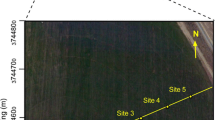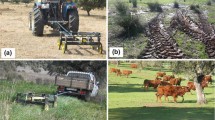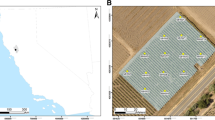Abstract
Electromagnetic induction (EMI) is a non-destructive technique to measure the apparent electrical conductivity (ECa) of agricultural soils. It has become popular in precision agriculture applications to estimate crop yield from ECa. This study was conducted to relate ECa with soil moisture content (θv) and potato tuber yield under Prince Edward Island (PEI), Canada growing conditions and to establish a two-layered soil model for ECa. During year one, horizontal co-planar (HCP), perpendicular co-planar (PRP), and θv were measured with DUALEM-2 sensor and time domain reflectometry (TDR) probe and correlated with yield measured from 12 m2 grids at 40 locations in each of the two potato fields on PEI. During 2018, vertical electrical sounding was undertaken by raising the DUALEM-2 from ground-level at 0.2 m intervals to a height of 1.6 m to investigate variations in ECa with soil depth. A two-layered soil model was developed using generalized reduction gradients to determine the surficial conductivity and thickness, and subsurface conductivity. ECa variables (HCP and PRP), θv, and yield were significantly correlated and remained consistent throughout the study period, indicating their potential in predicting potato tuber yield. ECa in the fields varied both spatially and laterally with depth. GIS interpolated maps of a representative set of data for HCP and tuber yield (2017 data) showed structured spatial patterns and thus feasibility for delineating management zones. Further studies should examine the potato root zone (0.15–0.3 m) ECa specifically for developing higher layered models, which may be useful for accurate prediction of tuber yield. Non-destructive and accurate yield mapping using DUALEM-2 sensor combined with mathematical modelling of soil ECa layering has potential for use in developing management zones in potato fields.







Similar content being viewed by others
References
Abdu, H., Robinson, D. A., & Jones, S. B. (2007). Comparing bulk soil electrical conductivity determination using the DUALEM-1S and EM38-DD electromagnetic induction instruments. Soil Science Society of America Journal,71(1), 189–196. https://doi.org/10.2136/sssaj2005.0394.
Al-Gaadi, K. A., Hassaballa, A. A., Tola, E., Kayad, A. G., Madugundu, R., Alblewi, B., et al. (2016). Prediction of potato crop yield using precision agriculture techniques. PLoS ONE,11(9), 1–16. https://doi.org/10.1371/journal.pone.0162219.
Bai, W., Kong, L., & Guo, A. (2013). Effects of physical properties on electrical conductivity of compacted lateritic soil. Journal of Rock Mechanics and Geotechnical Engineering,5, 406–411. https://doi.org/10.1016/j.jrmge.2013.07.003.
Callegary, J. B., Ferre, T. P. A., & Groom, R. W. (2007). Vertical spatial sensitivity and exploration depth of low-induction-number electromagnetic induction instruments. Vadose Zone Journal,6(1), 158–167. https://doi.org/10.2136/vzj2006.0120.
Cambouris, A. N., Nolin, M. C., Zebarth, B. J., & Laverdiere, M. R. (2006). Soil management zones delineated by electrical conductivity to characterize spatial and temporal variations in potato yield and in soil properties. American Journal of Potato Research,83(5), 381–395. https://doi.org/10.1007/BF02872015.
Cemek, B., GüLer, M., Kiliç, K., Demir, Y., & Arslan, H. (2007). Assessment of spatial variability in some soil properties as related to soil salinity and alkalinity in Bafra plain in northern Turkey. Environmental Monitoring and Assessment,124, 223–234. https://doi.org/10.1007/s10661-006-9220-y.
De Caires, S. A., Wuddivira, M. N., & Bekele, I. (2015). Spatial analysis for management zone delineation in a humid tropic cocoa plantation. Precision Agriculture,16, 129–147.
Farooque, A. A., Zaman, Q. U., Schumann, A. W., Madani, A., & Percival, D. C. (2012). Delineating management zones for site specific fertilization in wild blueberry fields. Applied Engineering in Agriculture,28, 57–70.
Gebbers, R., Luck, E., & Heil, K. (2007). Depth sounding with the EM38-detection of soil layering by inversion of apparent electrical conductivity measurements. In J. V. Stafford (Ed.), Precision Agriculture’07 Proceedings of the 6thEuropean Conference on Precision Agriculture (pp. 95–102). Wageningen, The Netherlands: Wageningen Academic Publishers.
Hendrickx, J. M. H., Borchers, B., Corwin, D. L., Lesch, S. M., Hilgendorf, A. C., & Schlue, J. (2002). Inversion of soil conductivity profiles from electromagnetic induction measurements. Soil Science Society of America Journal,66, 673–685. https://doi.org/10.2136/sssaj2002.6730.
Hendrickx, J. M. H., & Kachanoski, R. G. (2002). Non-intrusive electromagnetic induction. In J. H. Dane & G. C. Topp (Eds.), Methods of soil analysis. Part 4: Physical method (pp. 1297–1306). Madison, WI, USA: Soil Science Society of America.
Jaynes, D. B., Colvin, T.S., & Ambue, J. (1993). Soil type and crop yield determinations from ground conductivity surveys. Paper 933552, St. Joseph, MI, USA: ASAE.
Khakbazan, M., Henry, R., Haung, J., Mohr, R., Peters, R., Fillmore, S., et al. (2015). Economics of organically managed and conventional potato production systems in Atlantic Canada. Canadian Journal of Plant Science,95, 161–174. https://doi.org/10.4141/cjps-2014-050.
Khosla, R., Fleming, K., Delgado, J. A., Shaver, T. M., & Westfall, D. G. (2002). Use of site-specific management zones to improve nitrogen management for precision agriculture. Journal of Soil and Water Conservation,57, 513–518.
Kitchen, N. R., Sudduth, K. A., & Drummond, S. T. (1996). Mapping of sand deposition from 1993 midwest floods with electromagnetic induction measurements. Journal of Soil and Water Conservation,51, 336–340.
Kitchen, N. R., Sudduth, K. A., & Drummond, S. T. (1999). Soil electrical conductivity as a crop productivity measure for claypan soils. Journal of Production Agriculture,12(4), 607–617. https://doi.org/10.2134/jpa1999.0607.
Laekemariam, F., Kibret, K., Mamo, T., Karltun, E., & Gebrekidan, H. (2016). Physiographic characteristics of agricultural lands and farmers’ soil fertility management practices in Wolaita zone, Southern Ethiopia. Environmental Systems Research,5, 24. https://doi.org/10.1186/s40068-016-0076-z.
Li, Y., Shi, Z., Wu, C. F., Li, H. Y., & Li, F. (2008). Determination of potential management zones from soil electrical conductivity, yield and crop data. Journal of Zhejiang University Science B,9(1), 68–76. https://doi.org/10.1631/jzus.B071379.
Lund, E. D., Christy, C. D., & Drummond, P. E. (2000). Using Yield and Soil Electrical Conductivity (EC) Maps to Derive Crop Production Performance Information. 5th International Conference on Precision Agriculture, Madison, WI, USA: ASA-SSSA-CSSA. pp. 1–10.
McNeill, J. D. (1980a). Electrical conductivity of soils and rocks. Technical Note TN-5. Geonics Ltd, Mississauga, ON, Canada.
McNeill, J.D. 1980b. Electromagnetic terrain conductivity measurement at low induction numbers. Technical Note TN-6. Geonics Ltd., Mississauga, ON, Canada.
Neupane, J., & Guo, W. (2019). Agronomic Basis and Strategies for Precision Water Management: A Review. Agronomy,9(2), 87. https://doi.org/10.3390/agronomy9020087.
Perron, I., Cambouris, A. N., Chokman, K., Vargas Guiterrez, M. F., Zebarth, B. J., Moreau, G., et al. (2018). Delineating soil management zones using a proximal soil sensing system in two commercial potato fields in New Brunswick, Canada. Canadian Journal of Soil Science,98(4), 724–737. https://doi.org/10.1139/cjss-2018-0063.
Rhoades, J. D., Manteghi, N. A., Shrouse, P. J., & Alves, W. J. (1989). Soil electrical conductivity and soil salinity: new formulations and calibrations. Soil Science Society of America Journal,53, 433–439.
Ryšan, L., & Šařec, O. (2008). Research of correlation between electric soil conductivity and yield based on the use of GPS technology. Research in Agricultural Engineering,3, 136–147. https://doi.org/10.17221/714-RAE.
Saey, T., Simpson, D., Vermeersch, H., Cockx, L., & Meirvenne, M. V. (2009). Comparing the EM38DD and DUALEM-21S sensors for depth-to-clay mapping. Soil Science Society of America Journal,73(1), 7–12. https://doi.org/10.2136/sssaj2008.0079.
Santos, F. A., Triantafilis, J., Bruzgulis, K. E., & Roe, J. A. E. (2010). Inversion of Multiconfiguration Electromagnetic (DUALEM-421) Profiling Data Using a One-Dimensional Laterally Constrained Algorithm. Vadose Zone Journal,9(1), 117–125. https://doi.org/10.2136/vzj2009.0088.
Schumann, A. W., & Zaman, Q. U. (2003). Mapping water table depth by electromagnetic induction. Applied Engineering in Agriculture,19(6), 675–688. https://doi.org/10.13031/2013.15663.
Shanahan, P. W., Binley, A., Whalley, W. R., & Watts, C. W. (2015). The use of electromagnetic induction to monitor changes in soil moisture profiles beneath different wheat genotypes. Soil Science Society of America Journal,79, 459–466. https://doi.org/10.2136/sssaj2014.09.0360.
Sherlock, M. D., & McDonnell, J. J. (2003). A new tool for hillslope hydrologists: Spatially distributed groundwater level and soil water content measured using electromagnetic induction. Hydrological Processes,17, 1965–1977. https://doi.org/10.1002/hyp.1221.
Statistics Canada. (2016). Farm and Farm Operator Data: Prince Edward Island has the largest potato crop in Canada. Catalogue no. 95-640-X, https://www150.statcan.gc.ca/n1/pub/95-640-x/2016001/article/14801-eng.htm
Sudduth, K. A., Kitchen, N. R., Weibold, W. J., Batchelor, W. D., Bollero, G. A., Bullock, D. G., et al. (2005). Relating apparent electrical conductivity to soil properties across the north-central USA. Computers and Electronics in Agriculture,46(1–3), 263–283. https://doi.org/10.1016/j.compag.2004.11.010.
Wait, J. R. (1962). A note on the electromagnetic response of a stratified earth. Geophysics,27, 382–385. https://doi.org/10.1190/1.1439028.
Wang, Z., Tang, C., Wang, H., Zhao, C., Yin, D., Yuan, Y., et al. (2019). Effect of different amounts of biochar on meadow soil characteristics and maize yields over three years. BioResources,14(2), 4194–4209.
Wilding, L. (1985). Soil spatial variability: Its documentation, accommodation and implication to soil surveys. In D. R. Nielsen & J. Bouma (Eds.), Soil spatial variability, proceedings of a workshop of the ISSS and the SSSA (pp. 166–187). Wageningen, The Netherlands: PUDOC.
Zare, M., Farooque, A. A., Abbas, F., Zaman, Q., & Bos, M. (2019). Trends in the variability of potato tuber yield under selected land and soil characteristics. Plant, Soil and Environment,65(3), 111–117.
Acknowledgements
This research was supported by Natural Science and Engineering Council of Canada, Canadian Hort Council, Agriculture and Agri-Food Canada and New Brunswick Department of Agriculture, Aquaculture and Fisheries (Canadian Agriculture Adoption Program).
Author information
Authors and Affiliations
Corresponding author
Additional information
Publisher's Note
Springer Nature remains neutral with regard to jurisdictional claims in published maps and institutional affiliations.
Rights and permissions
About this article
Cite this article
Tang, S., Farooque, A.A., Bos, M. et al. Modelling DUALEM-2 measured soil conductivity as a function of measuring depth to correlate with soil moisture content and potato tuber yield. Precision Agric 21, 484–502 (2020). https://doi.org/10.1007/s11119-019-09678-2
Published:
Issue Date:
DOI: https://doi.org/10.1007/s11119-019-09678-2




